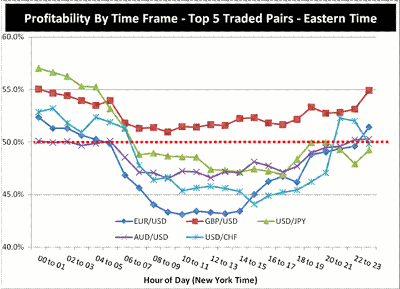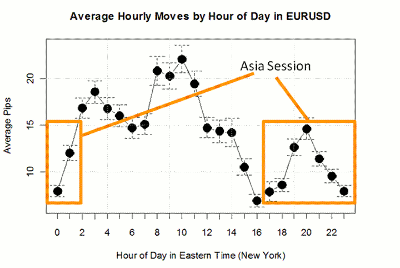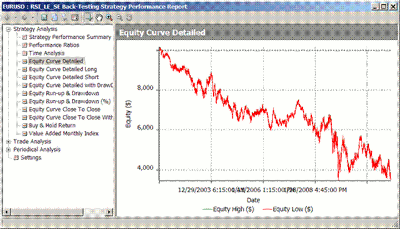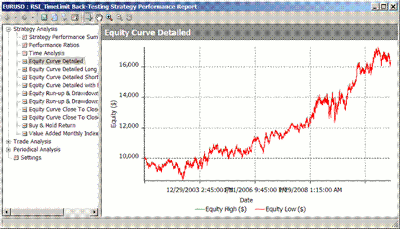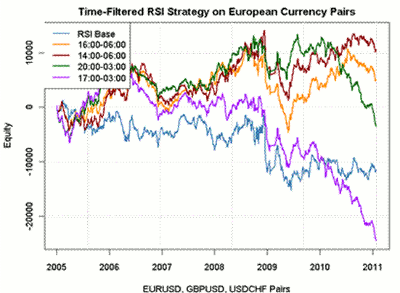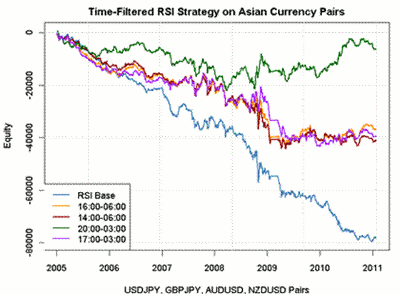For most forex traders, the best time of day to trade is during a specific continent’s market hours when European currency pairs such as EUR/USD show the best results, writes David Rodriguez of DailyFX.com.
In looking at the trading records of tens of thousands of forex traders, as well as talking with even more traders daily via Webinars, e-mail, and chat sessions, it quickly becomes apparent that most individual forex traders are what are called “range traders.”
It also becomes apparent that many of them have trouble becoming successful in forex because they are trading during the wrong time of day.
Most forex traders should trade during the late-US, Asian, or early-European trading sessions— essentially 2 pm to 6 am Eastern Time (New York), which is 7 pm to 11 am UK time.
These traders should avoid trading during the most active times of the trading day. Why? We’ve seen records for thousands of traders, and we’ve seen what works and what doesn’t. Here is a chart of the profitable trades in FXCM accounts in the five most popular pairs, displayed by the hour of day:
You can see that this generally correlates with the low-volatility trading hours. Traders tend to see the best results during the low-volatility Asian session hours:
This is because most individual forex traders use “range-trading” strategies, buying oversold currencies near support and selling overbought currencies near resistance. These tend to work well during low-volatility times, when support and resistance tends to hold. Range traders can incur significant losses when support or resistance is broken, which happens most often during the more volatile times of day.
NEXT PAGE: Do the Hours I Trade Matter?
|pagebreak|Do the Hours I Trade Matter?
Yes, they matter a lot.
We have constructed a strategy that closely models your “typical” trader (you can find a full description of the model strategy at the end of this article). We simulated the strategy’s performance trading the EUR/USD 24 hours a day over the past ten years. The results are not good.
EUR/USD RSI Range Strategy Performance, Trading 24 Hours
However, once we factor in the time of day, things become interesting. Let’s say you made a rule to only trade during low-volatility times.
This next chart shows the exact same strategy over the exact same time window, but the system does not open any trades during the most volatile time of day, 6 am to 2 pm ET (11 am to 7 pm London time). The difference is dramatic.
EUR/USD RSI Strategy, Restricted to Trade between 2:00 pm and 6:00 am ET
By sticking to range trading only during the hours of 2 pm and 6 am ET, the typical trader would have been far more successful over the past ten years than the trader who ignored that time of day.
NEXT PAGE: What About Other Currency Pairs?
|pagebreak|What About Other Currency Pairs?
Of course, not all currencies act the same. For example, the Japanese yen tends to see more volatility during Asian hours than the euro or British pound, since that is the Japanese business day.
We simulated the same strategy using several different possible time settings for the three major European pairs, EUR/USD, GBP/USD, and USD/CHF.
The below chart shows combined results for the strategy on the EUR/USD, GBP/USD, and USD/CHF during different time frames (in the New York time zone). As you can see, using this strategy overnight during the Asian and early-European session has yielded much better results than our baseline 24-hour RSI.
We find that the same time filters work very well for the EUR/USD and USD/CHF, as they are closely correlated. The filters also work fairly well for the GBP/USD. You should range trade these currency pairs during the 2 pm to 6 am ET window.
Unfortunately, our optimal time window does not work well for Asian currencies. Our tests of different time windows on the USD/JPY, AUD/USD, and NZD/USD have not produced a single positive equity curve over the past six years. This is due to the fact that these currencies are more often subject to large moves during the Asian session than the European currencies.
It is worth noting that the time of day can have a significant effect on returns in these currencies as well. Twenty-four-hour trading shows far greater losses than the other time windows.
Game Plan: What Strategy Should I Use?
Trade European currencies during “off hours” using a range-trading strategy.
Our data show that over the past ten years, many individual currency traders have been successful in range trading European currency pairs during the “off hours” of 2 pm-6 am ET (7 pm to 11 am UK time).
Many traders have been very unsuccessful trading these currencies during the volatile 6 am to 2 pm ET period. Asia-Pacific currencies can be difficult to range trade at any time of day due to the fact that they tend to have less-distinct periods of high and low volatility.
Model Strategy: Range Trading with RSI on a 15-Minute Chart
For our models, we simulated a “typical” trader using one of the most common and simple intraday range-trading strategies there is: following RSI on a 15-minute chart.
- Entry Rule: When the 14-period RSI crosses above 30, buy at market on the open of the next bar. When RSI crosses below 70, sell at market on the open of the next bar
- Filter: Strategy cannot enter trades between the “end hour" and the next “start hour"
- Exit Rule: Strategy will exit a trade and flip direction when the opposite signal is triggered
As was shown earlier, this strategy has worked best over the past ten years using European currency pairs and setting the start hour to 2 pm and the end hour to 6 am Eastern time (New York).
By David Rodriguez, Quantitative Strategist, DailyFx.com

